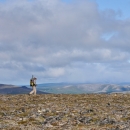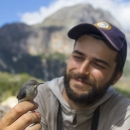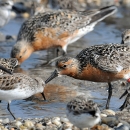Overview
The roselaari Red Knot population is one of North America’s rarest shorebird populations (Lyons et al. 2015). It is listed as endangered in Mexico and threatened in Canada. In the United States, the roselaari Red Knot have shown declines in their breeding and migration areas (Tomkovich and Dondua 2008, Buchanan et al. 2010), but the subspecies was denied threatened status by the USFWS based on a lack of information. This project acts in direct response to the USFWS’ request for information and will provide data used to estimate their survival. Demographic information like this is required by the USFWS and its partners to complete species status assessments, model population dynamics, and set conservation and management objectives.
Specifically, this project has the following objectives:
- To collect information on Red Knot adult survival and brood survival on the breeding grounds in Nome, Alaska to support ongoing analyses, including an integrated population model.
- Determining how food supply and climate affect growth and survival of Red Knot chicks.
- Sharing information gained during these activities to inform and engage the general populace about the plight of this species and improve existing conservation measures underway by species’ specialist groups.
Importance of this Work
North America-breeding shorebirds are declining faster than many other bird species (Smith et al. 2023), and Red Knots are no exception. The roselaari Red Knot subspecies is one of the rarest shorebird populations that breed in North America. The entire population of roselaari occurs in Alaska during spring and fall migration, making Alaska an integral part of the subspecies’ life. Most roselaari Red Knots winter in Guerrero Negro, Mexico, but some winter as far south as Chiloe Island, Chile (Carmona et al. 2013), further adding to the complexities for conserving this subspecies.
Actions WE ALL can take
Giving them Space. Shorebirds, including the roselaari Red Knot, depend on variety of habitats throughout the year to meet their daily needs and survive their impressive, annual migrations. Beaches and wetlands like estuaries, mudflats, lake edges, and seasonally flooded lands (agricultural fields, for example) are just a few habitats that shorebirds rely on to survive. Beach/coastal walking, a seemingly harmless activity, can have negative consequences on shorebirds that are using the area for rest, foraging, or nesting. In some parts of the U.S., human disturbance is one of the most significant threats to shorebird populations. These threats can intensify as human use (coastal recreation, off-leash dogs) in these coastal areas increases, leading to an overall reduction in suitable, undisturbed habitats for shorebirds.
If you are recreating near a coastline, shoreline, or other wetland type used by shorebirds, please give the shorebirds space—ideally, do not approach within 200 m (656 ft). If you are recreating with a dog, please keep your dog leased, as the presence of dogs is directly related to shorebirds expending more energy being alert to their presence. If you are located in Anchorage, the municipal law requires you to restrain your dog in public places unless you are in a designated off-lease dog park. Learn more about how leashing your dogs protects birds from the National Audubon Society.
Participating in citizen science. Anyone can contribute valuable data by submitting what they see to citizen science programs like eBird or becoming an International Shorebird Survey volunteer. Shorebirds, including Red Knots, lend themselves to being quite visible outside the breeding season, congregating in large flocks and utilizing visible habitats like beaches and shorelines. Casual bird sightings can be a valuable data points for scientists. By submitting your bird sightings to eBird, or participating in the International Shorebird Survey you can play a crucial role in helping scientists monitor shorebirds like the Red Knot.
Spreading the Word: Share information about shorebirds and their threats with your family, friends, and neighbors. Talk to them about how sustained public support are crucial to ensure the future of this group of birds.






